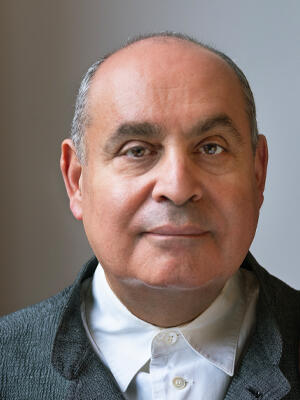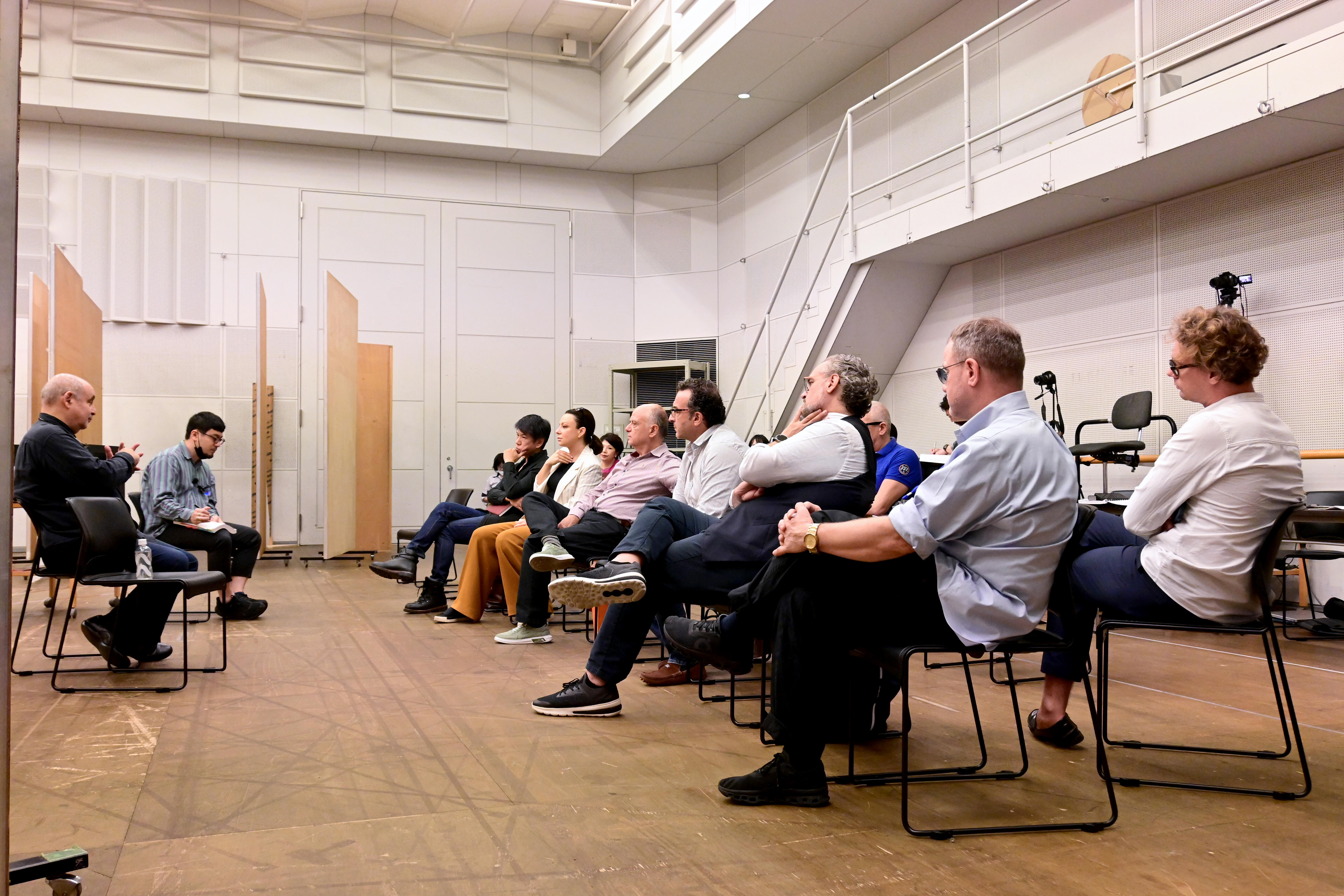Interview: Pierre Audi on "Simon Boccanegra"
 ―You are making your directorial debut at the New National Theatre Tokyo with Simon Boccanegra. Have you worked with Maestro Kazushi Ono previously?
―You are making your directorial debut at the New National Theatre Tokyo with Simon Boccanegra. Have you worked with Maestro Kazushi Ono previously?
We've known each other for many years, but it's the first time to work together in the theatre. When I was the Artistic Director at the Dutch National Opera in Amsterdam, he followed my work and came to see the productions I directed such as Wagner's Ring cycle. So we always imagined doing something together one day, and I'm grateful to have the opportunity to direct this production of Simon Boccanegra at the New National Theatre Tokyo.
―You have directed numerous operas at the Dutch National Opera and at many major opera houses and music festivals in Europe and America, but in fact you haven't directed that many Verdi works. Is there a reason for this?
The first Verdi opera I directed was Jerusalem back in 1990, early on in my directorial career. It was for Opera North in the U.K. and this was the British premiere of the work. I then directed Attila at the Metropolitan Opera (2010) and Rigoletto at Vienna State Opera (2014). So this is my fourth Verdi opera.
It's true I'm more somebody who is interested in the difficult pieces, the strange pieces. Of course, I'm not saying La Traviata is easy. It's just that there are already several people doing interesting Traviatas, so I don't need to add my stamp on that. But there are fewer people doing the difficult operas or trying to do something interesting with the difficult operas.
―Do you remember the first time you saw Simon Boccanegra?
Simon Boccanegra is an opera I've always loved, especially the music. I used to listen to it a lot as a student after I saw the famous production at Covent Garden, so I know the music by heart, almost. But I always realized it's a very difficult opera to try to stage and I have never thought of doing it. So when Kazushi suggested it to me, I thought for a long time: How do I do it? What approach?
Simon Boccanegra has a complicated plot, which is impossible for the audience to understand. But I don't think you need to understand the plot too much because the music is the guiding force of this opera. The story behind the personage is very complicated, but the music is much more pure and telling a simple story. It's basically the journey of a man who comes to power, not expecting it. And if you focus on this journey, you don't need to understand so much the detail of that faction or that faction. You just have to see how power isolates people, and isolates them also from their private life and their emotions. And that enemies, even big enemies, can reconcile through private grief. Those are the main themes of the opera. It's not really a political opera. The main subject of the opera is the loneliness of this man Boccanegra and I think this is what you hear in the music from the first note to the last note.

Explanation of the production concept

Explanation of the production concept
―The set designer is the celebrated British artist Anish Kapoor, with whom you have collaborated previously.
I've always enjoyed collaborating with visual artists. It's very difficult to get an artist to work in the theatre, but I've done it a lot and I know how to do it. So I asked Anish Kapoor with whom I did two other operas: Pélleas et Mélisande at La Monnaie (2008) and Parsifal at the Dutch National Opera (2012). He is very fond of opera, and when we discussed the project, he told me he loves the music of Simon Boccanegra and he came up with one idea ― which is always like that with artists. You can't expect artists to offer you several ideas. It's usually one reaction and you have to find a way to build the production from that idea. So, to create an effect that corresponds with the idea of the design as he conceives it is not easy and the realization is very complex. Building the set in Milan was a very big operation because it was very unusual, and also because it's a co-production with Helsinki and Madrid and it has to fit into all theatres.
―Could you share your concept for this production?
The opera has a prologue that takes place 25 years before the main opera. This is a strange prologue in which we discover the relationship between Fiesco and Boccanegra, which is very bitter. This is very tricky to stage. For this prologue, we have an abstract translation of the stage representing sails of boats, because the opera is set in the port city of Genoa. It's like a landscape of sails, very black at the beginning.
And then in the first, second and third acts, we have basically one image: an upside down volcano which is dominating the stage. This comes from the three plays on Empedocles that Friedrich Hölderlin, the German Romantic philosopher, wrote. Empedocles was an ancient Greek philosopher who was a very lonely figure and lived on the edge of Mount Etna, the volcano. And in a way, that's what Boccanegra is. He's a lonely man left between life and death. So everything is happening under this volcano, under the shadow of the volcano. In the last act where he's dying, the stage is full of lava from this volcano. It's like finally he is eaten up by the volcano.
I know Kapoor's inspiration was Mount Etna, but I feel both the volcano and the sea have connections with Japan because it's about nature, and you can do nothing against a volcano that's erupting. So you are, in a sense, adrift, and you have to accept that life reserves surprises for you, which you don't know when they're going to come.
―You are currently the Artistic Director of the Aix-en-Provence Festival and the Park Avenue Armory in New York. How much opera directing do you do these days?
I do about one thing a year ― maximum two things a year. This is the only production I'm doing this year. Last year I did Gluck's Orfeo ed Euridice at the Maggio Musicale in Florence with conductor Daniele Gatti, and I did an open air production in Linz based on the epic of Gilgamesh, which was a very special event.
I don't want to stop directing, but I've done so much that I'm happy to do less. I'm very motivated by the work of other directors. I love supporting other directors. I guess that's unusual. For me, supporting another director is like doing a production myself.
―Is this the first time to work in Japan since you directed the production of Tan Dun's TEA at Suntory Hall?
Yes, TEA, a commission from Suntory Hall, was premiered in 2002, and revived again in 2006. This was the only previous time I worked in Japan, but I've always loved traditional Japanese theatre and when I was director of the Holland Festival, I presented kabuki, noh, kyogen, bunraku and gagaku. Also I worked with Satoshi Miyagi (2019) in Antigone at the Armory in New York, and I worked with the dancer and choreographer Min Tanaka in Mozart's Die Zauberflöte in Amsterdam (1995) and Salzburg (2006). So I've had several connections with Japan over the years.
Therefore I'm interested in seeing the connection between Simon Boccanegra and Japanese culture in this production. It's interesting because there is something very ritualistic about the opera that corresponds to the rhythm of Japanese storytelling. So this connection between this opera and Japan is definitely kind of interesting for me.
―We are greatly looking forward to the production.
Interview by Nahoko Gotoh
From the rehearsal of Simon Boccanegra
From the rehearsal of Simon Boccanegra
Opera ❝Simon Boccanegra❞
On Stage 15, 18, 21, 23, 26 November.
See here for more information.

